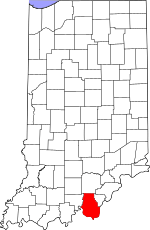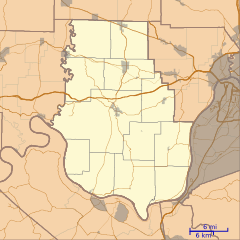Central Barren, Indiana facts for kids
Quick facts for kids
Central Barren, Indiana
|
|
|---|---|

Harrison County's location in Indiana
|
|
| Country | United States |
| State | Indiana |
| County | Harrison |
| Township | Morgan |
| Elevation | 791 ft (241 m) |
| ZIP code |
47161
|
| FIPS code | 18-11872 |
| GNIS feature ID | 432350 |
Central Barren is a small, unincorporated community located in Harrison County, Indiana. An "unincorporated community" means it's a place where people live, but it doesn't have its own local government like a city or town. It's part of Morgan Township.
Contents
A Look Back: History of Central Barren
The Mysterious Barrens
Long ago, early settlers in Harrison County gave the name "barrens" to certain areas. These lands were different because they didn't have many trees. Instead, they looked more like prairies, covered mostly with grass and small bushes.
At first, people didn't want to live in these barren areas. They needed timber to build homes, make fires, and create fences. The barrens were too far from the forests that provided these important resources.
Fires and Fertile Land
Another challenge for the barrens was the annual field fires. These fires would burn off most of the plants growing there. This made the land seem even less appealing for settlement.
However, as more people moved into the area in the early 1800s, farmers made an amazing discovery. They found that because of these fires, the barrens actually had some of the most fertile soil in Indiana! The land was perfect for growing crops.
From Prairie to Forest
Once settlers realized how good the soil was, the barrens quickly became filled with landowners. As more people settled, they were able to work together. They stopped the wild fires that had prevented trees from growing.
By the early 1900s, many parts of the barrens that used to be treeless began to grow into forests. Much of this land has remained forested up to modern times.
The Post Office
Central Barren also had a post office for a short time. It was opened in 1890. However, it only stayed in operation for about 15 years, closing down in 1905.


